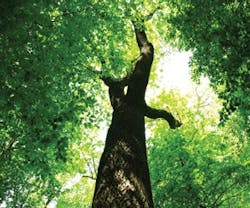While trees have great ornamental value, you can also leverage their shade to reduce energy costs, manage stormwater, intercept pollutants, and target the heat island effect. View your trees as natural capital and maximize their placement for energy and water efficiency.
Conserve Energy and Water
As a tree’s canopy expands, so do opportunities for energy savings. During the summer, trees act as natural solar shades by deflecting heat away from the building yet allow enough light to pass through to preserve daylighting measures.
In the winter, deciduous trees can act as a wind barrier. Use a wedge configuration of prairie grasses, shrubs, and trees to vault cold air up and over your facility. These measures will reduce energy consumption by up to 25% once the trees reach maturity, says Sean Barry, director of media relations for the Arbor Day Foundation.
Tree shade actively reduces the heat island effect, lowering surface temperatures between 20-45 degrees F. “A parking lot with 50% shading can also eliminate one ton of emissions per day while extending the life of the pavement,” Barry explains. Not only do patrons and employees appreciate a cooler place to park, but shading also decreases a lot’s maintenance needs.
Trees also offer beneficial stormwater management and soil erosion protection because they can capture hundreds of gallons of water during a rainfall, says Barry.
“The tree’s canopy intercepts a portion of rain and absorbs the excess through its roots,” says Meredith Borchardt, program manager and field coordinator for Trees Forever, a non-profit environmental organization. By helping the water to infiltrate the ground, trees prevent soils from washing away. Because all vegetation filters runoff, a property lush with trees also creates a safer environment for nearby waterways.
Leafing Through Tree Options
While some trees offer aesthetic benefits, they may not be suited to your region’s climates or for harsh urban areas, warns Ruth Fox, ASLA for Ruth L. Fox Landscape Architecture and Planning. Pick a variety of trees that have a good structure and can withstand your property’s demands.
“Look for tree types that develop a strong trunk and branch system, particularly with branches that are angled properly for freeze-thaw cycles,” Fox recommends.
You should also consider the mature size of the tree, says Borchardt. “A tree that grows to be 80 to 100 feet will give you more bang for your buck than small ornamental trees.”
Trees should be planted with a strategy in mind. Look for areas on the west and northwest sides of your property, which will provide mid-to-late afternoon shading.
You can also plant near air conditioning units and concrete areas like patios or walkways for additional energy savings, Barry recommends.
Be cautious of planting trees directly in the middle of a parking lot. If not enough room is left for the root system, the tree’s growth will be cramped and it will absorb inappropriate levels of heat from the concrete. The perimeter is a more secure location and will still afford heat island benefits, says Fox.
You can also help protect trees in urban spaces by placing a layer of mulch at the base. “Mulch can really help with water retention, especially near competing turf grass,” Borchardt explains. “Use a layer of mulch 2 to 3 inches deep and as wide as the canopy to help the tree thrive in that setting.”
Patience Yields Results
With the slow growth of trees, it can take 5-10 years for quantifiable energy savings to show up on your utility bill, says Fox. But much like compound interest, a tree’s value only multiplies as the years pass.
“Tree planting is truly an investment because the benefits continue to grow over time,” Barry explains. “When people think of their favorite neighborhoods and business districts, they tend to remember the ample tree life and green spaces. We are able to enjoy these spaces today because of the wise investment someone made 40 or more years ago.”
Jennie Morton ([email protected]) is associate editor of BUILDINGS.
About the Author
Jennie Morton
A former BUILDINGS editor, Jennie Morton is a freelance writer specializing in commercial architecture, IoT and proptech.
